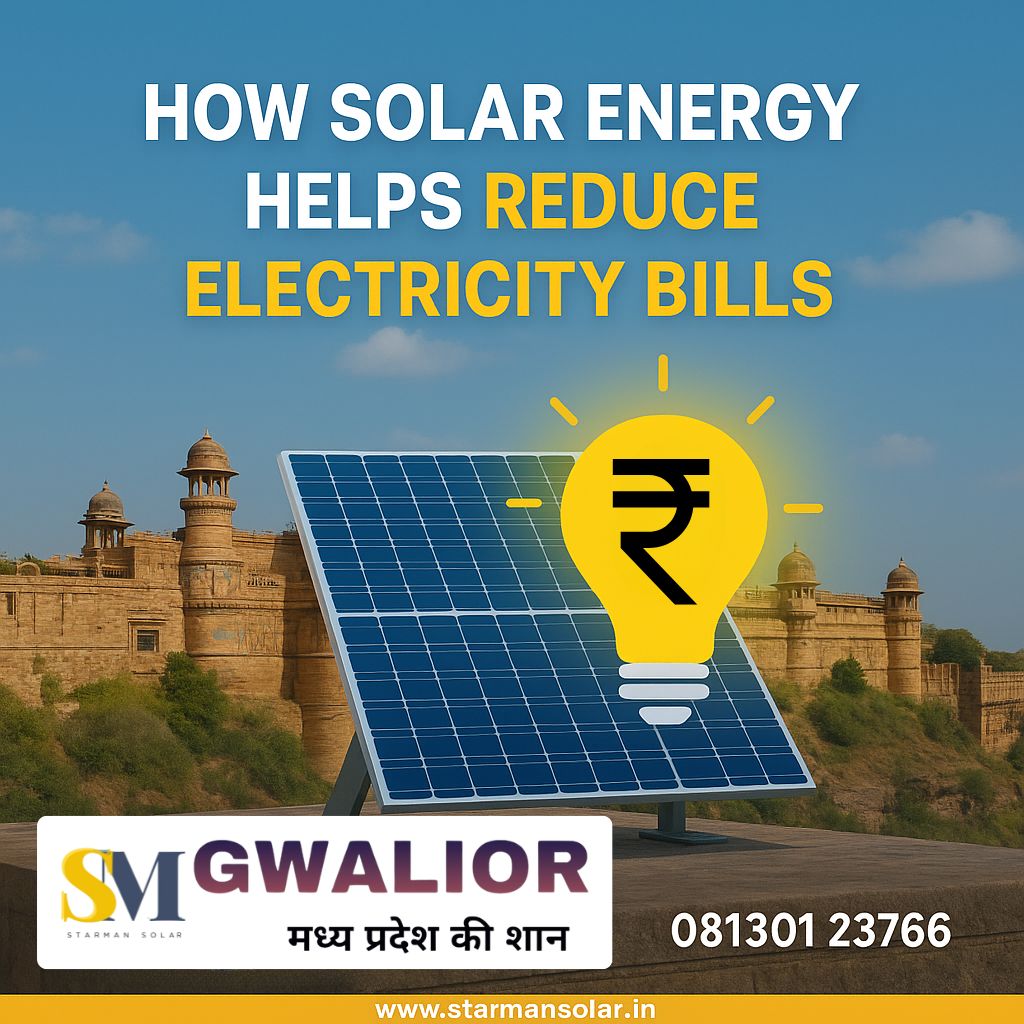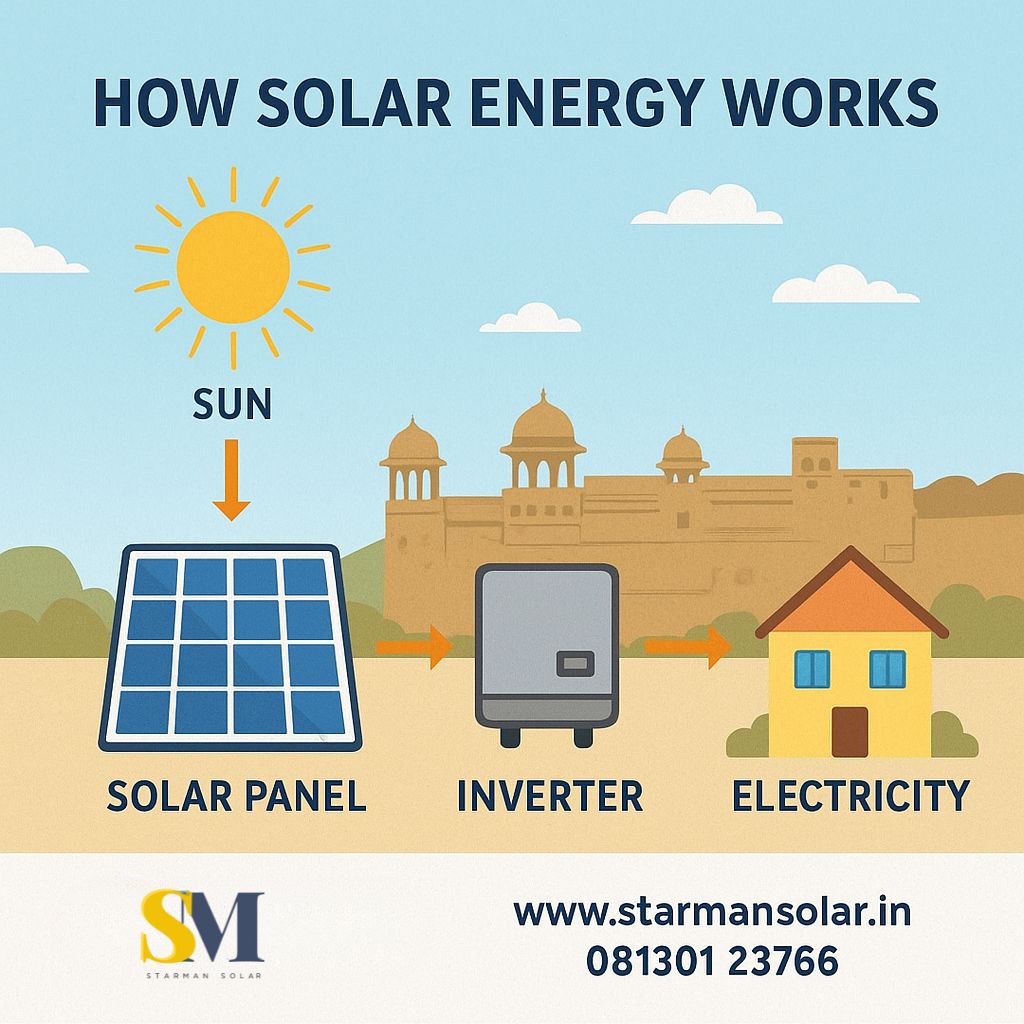How Solar Energy Helps Reduce Electricity Bills
- starman
- September 12, 2025
- 10:41 am
- No Comments


This guide by Starman Solar explains in detail how solar energy helps reduce electricity bills, especially in India, where abundant sunlight makes solar energy not only viable but highly economical.
The Basics: How Does Solar Energy Reduce Electricity Bills?
The science is simple. Solar panels convert sunlight into electricity using photovoltaic (PV) technology. This electricity powers your lights, fans, ACs, and appliances. The more energy your solar system generates, the less you draw from the traditional power grid—resulting in significantly lower monthly bills.
In some cases, especially with net metering, you can even export surplus energy back to the grid, further reducing your electricity cost or earning credits.
Explain How Solar Energy Helps Reduce Electricity Bills – Step-by-Step
- Installation of Solar Panels: Panels are mounted on your roof where they receive maximum sunlight.
- Conversion of Sunlight to Electricity: PV cells convert sunlight to DC electricity.
- Inverter Conversion: An inverter converts DC into usable AC electricity.
- Supply to Home Appliances: This electricity powers your daily needs.
- Surplus Power Handling: Excess power is stored in batteries or sent to the grid.
This complete cycle explains exactly how solar energy reduces electricity bills while making you energy-independent.
What Are 10 Advantages of Solar Energy?
- Reduces electricity bills
- Low maintenance
- Eco-friendly
- Renewable energy
- Government subsidies
- Increases property value
- Energy independence
- Works in remote areas
- Net metering benefits
- Long-term savings
Despite a few disadvantages of solar energy like high initial costs or performance drop during monsoons, the benefits far outweigh the cons.
Disadvantages of Solar Energy
While solar is beneficial, consider these limitations:
- Initial Investment: Though decreasing, setup cost is still considerable.
- Weather Dependent: Cloudy days or monsoons can lower output.
- Storage Costs: Battery storage systems can be expensive.
- Space Requirement: Large setups need adequate rooftop area.
However, with Starman Solar’s expert design and consultation, these issues can be managed efficiently.
How Much Solar Panel Is Required for Home Electricity?
The system size depends on your average monthly usage:
Monthly Usage (Units) | System Size Required |
150–200 | 1 kW |
300–400 | 3 kW |
500–600 | 5 kW |
Starman Solar helps homeowners calculate precise sizing based on their usage and available roof space.
The 20% Rule for Solar Panels
The 20% rule refers to ensuring no more than 20% of the solar panel area is shaded at any time during the day. Even partial shading can reduce the efficiency of the entire system. Proper planning and placement are essential to maximize energy generation.
FAQs
1. How does solar energy reduce electricity bills?
By generating your own electricity through solar panels, you reduce the number of units drawn from the grid. Less grid power = lower monthly bills. Net metering can further increase your savings by allowing you to earn credits for surplus power sent back to the grid.
2. Does a solar system save a full electricity bill?
Yes, if your system is sized correctly, you can cover 100% of your energy needs. In some months, you may even generate surplus power. However, savings depend on weather, usage, and system capacity.
3. How can solar energy save electricity?
Solar energy offsets your use of grid electricity by powering your home directly from sunlight. When more solar is used, fewer grid units are consumed, reducing the bill and strain on the electricity infrastructure.
4. What is the 20% rule for solar panels?
This rule advises that no more than 20% of your solar panel’s surface area should be in shadow at any point during the day. Panels should be installed where sunlight is uninterrupted to maintain high efficiency.
5. How much solar panel is required for home electricity?
A small home may need a 1–2 kW system, while a medium or large home may require 3–5 kW or more. The size depends on your average monthly usage. Starman Solar can help you assess your energy needs accurately.
Final Thoughts
There’s no doubt that solar energy helps reduce electricity bills—and not just a little. With proper planning, the savings can be substantial and long-term. Whether you’re motivated by cutting costs, protecting the environment, or gaining energy independence, solar is a smart investment.
Starman Solar offers complete solar solutions across India, from consultation to installation and post-sales service. Let us help you lower your bills and brighten your future.
Share:
starman
Related Posts

Founded in 2021, Starman Solar has emerged as a trusted name in renewable energy solutions in Gwalior.
Top Rated
Service 20255.0
CONtact WITH US
FOLLOW US
Starman Solar Pvt. Ltd. © 2025 All Rights Reserved | Designed By PR Digital Marketing


